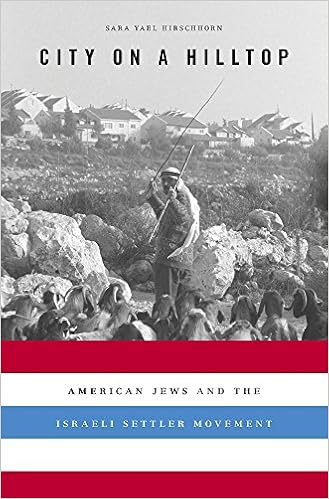
Thumbs up and thumbs down for "City on a Hilltop".
On the plus side, Sarah Yael Hirshhorn has invested an enormous amount of original research into detailing some aspects of American Jewish migration to the West Bank (historically Judaea and Samaria), and the Sinai's Yamit. They all became part of Israel after its stunning victory over Arab armies poised to destroy the Jewish state in 1967. Her narrative is readable and to me, as one who either personally knows or is acquainted with a good number of the personalities depicted, truly interesting.
On the minus side, Hirschhorn's stated goal "to provide an objective, rigorous, scholarly account" (p. 11) is not met. It's can't be objective if she refers dozens of times to the West Bank as "Israel/Palestine", when there's no current Palestinian state. Any use of "Israel/Palestine" is a politically loaded and pre-judged conclusion.
Just a handful of the author's negative characterizations --
She describes for 40 pages the efforts by Rabbi Shlomo Riskin, the famed former leader of Manhattan's Lincoln Square Synagogue, to establish Efrat, a highly desirable community in the Etzion bloc south of Jerusalem. Rabbi Riskin's religious moderation and daring innovations are well-known, as are his efforts to reach out to local Palestinian mukhtars willing to dialogue with him. Certainly over the course of 35 years in Efrat some of his early political views have changed given the reality of many more terror attacks around or in Efrat than the author cares to disclose, such as the infamous February 2002 Efrat supermarket terror bombing.
Yet in summing him up, Hirschhorn chooses leave the reader with a quote from a "progressive pundit": "Riskin could no longer masquerade as the liberal orthodox rabbi", but is really "a rightwing extremist in moderate's garb....through this life project, Riskin has caused more tragedy and pain to more Palestinians than any other rabbi of modern times, certainly more than Meir Kahane and his ilk" (p. 141).
Seth and Sherri Mandell of Efrat established a foundation to assist victims of Palestinian terror or other traumatic events after their teenage son Kobi was brutally murdered by Palestinian terrorists. Yet Hirschhorn complains, apparently with a straight face, that "it does not offer its services to bereaved Palestinians" (p. 172).
Hirschhorn begins her depiction of Tekoa, one of the three communities she describes in detail, as "deep the West Bank" (p. 143), and headlines the chapter, "Turn Left at the End of the World", subtle jabs. In reality, Tekoa is only seven miles east of Efrat.
The author discusses several cases of anti-Arab mayhem perpetrated by American immigrants to Israel. While the number of attackers is miniscule compared to the 60,000 Americans she estimates live on the West Bank, it's a necessary part of the discussion. Yet Hirschhorn is largely silent in describing the daily cascade of inflammatory anti-Israeli, anti-semitic rhetoric pouring out of the Palestinian media, whether it be from the official peace partners of the Palestinian Authority or the Hamas terrorists who rule Gaza, evacuated of its 21 Jewish communities in 2005 in a failed Israeli bid to achieve peace.
The author concludes that "American-Israeli immigrants within the settlement movement have contributed to making Israel less democratic while increasing conflict in the United States" (p. 228). I think that Hirschhorn's research -- as well as my own and my contemporaries' 50 years of interaction with these immigrants -- shows just the opposite. American olim largely do not accept stultifying Israeli bureaucracy or the commonly-heard phrase, "what can you do?" They act, they organize, they believe in a more democratic system, they always try to improve, they seek more communality with America.
What's the bottom line? "City on a Hilltop" is worthwhile reading -- but only if leavened with a healthy dose of skepticism for some of the author's descriptions, omissions and conclusions. It ain't the gospel truth.
No comments:
Post a Comment